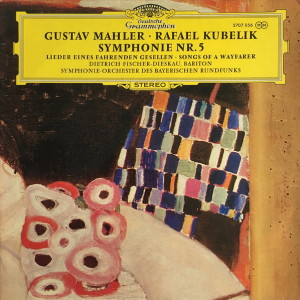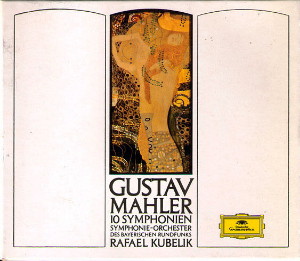 |
|
2 LP's
- 2707 056 - (p) 1971
|
 |
| 10 CD's
- 429 042-2 - (c) 1989 |
|
| GUSTAV
MAHLER (1860-1911) |
|
|
|
|
|
|
|
Long Playing 1 -
2530 189
|
|
42' 50" |
|
Symphonie Nr. 5
cis-moll
|
|
66' 03" |
|
| Erster Teil |
|
|
|
| -
1. Trauermarsch. In gemessenem
Schritt. Streng. Wie ein Kondukt |
11' 35" |
|
|
| - 2. Stürmisch
bewegt, mit grösster Vehemenz |
13' 52" |
|
|
| Zweiter Teil |
|
|
|
| - 3. Scherzo.
Kräftig, nicht zu schnell |
17' 23" |
|
|
Long Playing 2 -
2530 190
|
|
39' 21" |
|
| Dritter Teil |
|
|
|
-
4. Adagietto. Sehr langsam -
attacca:
|
9' 44" |
|
|
| -
5. Rondo-Finale. Allegro |
13' 29" |
|
|
| Lieder
eines fahrenden Gesellen |
|
16' 08"
|
|
| -
1. Wenn mein Schatz Hochzeit macht |
3' 51" |
|
|
| -
2. Ging heut' morgens übers Feld |
3' 59" |
|
|
| -
3. Ich hab' ein glühend Messer |
3' 10" |
|
|
| -
4. Die zwei blauen Augen |
5' 08" |
|
|
|
|
|
|
| Dietrich
Fischer-Dieskau, Baritone |
|
| Symphonie-Orchester
des Bayerischen Rundfunks |
|
Rafael KUBELIK
|
|
|
|
|
|
Luogo
e data di registrazione |
|
Herkules-Saal,
München (Germania):
- gennaio 1971 (Symphony)
- dicembre 1968 (Lieder)
|
|
|
Registrazione:
live / studio |
|
studio |
|
|
Executive
Producer |
|
Wilfried
Daenicke |
|
|
Recording
Producer
|
|
Hans
Weber (Symphonie), Rainer Brock
(Lieder: 1,2,4), Wolfgang Lohse
(Lieder: 3)
|
|
|
Balance
Engineer
|
|
Heinz
Wildhagen |
|
|
Prima Edizione
LP |
|
Deutsche
Grammophon - 2707 056 - (2 LP's) -
durata 42' 50" & 39' 21" - (p)
1971 - Analogico |
|
|
Prima Edizione
CD |
|
Deutsche
Grammophon - 429 042-2 - (10
CD's - 6°) - (c) 1989 - ADD
|
|
|
Note |
|
Illustration:
Gustav Klimt "Salome"
(Ausschnitt) |
|
|
|
|
The beginning
of the composition of his
Fifth Symphony marked the
opening of a new chapter of
Mahler's work in the
symphonic field.
Nevertheless in every
respect - intellectual,
musical, architectonic,
harmonic and textural - new
elements here came to the
forte. These elements are of
great importance to the
Fifth, Sixth and Seventh
Symphonies, which together
form a sub-group within
Mahler's symphonic uvre.
The Fourth was completed in
the summer of 1900, and the
Fifth was composed during
the following two years.
Nothing is known of any
outward experiences or inner
transformations during that
period which could account
for the new mode of
expression. There was,
therefore, no outward
struggle which could have
threatened the composer's
career and shattered his
peace of mind, so the
stylistic change in Mahler's
compositions must have been
entirely inward in its
origins, resulting from a
change of personality.
Mahler's music provides us
with the only indication
that his inner life
underwent a change at that
time. Prior to that the
source of his inspiration
had been a mystical concept
of life and of nature. His
music had been directed, as
it were, towards the
solution of the world's
problems. The mystery of the
giving of life to the
inanimate by spiritual means
had been the subject of his
musical aspirations. Now,
however, that theme was
exhausted. He had pursued it
into the most lofty, purest
spjeres until, freed from
all pathetic and dynamic
elements, it had dissolved
in fairy tales, symbols, and
the simple beliefs of
childhood. The composer now
had to make a new beginning,
to seek out a new way. There
was only one road to take;
it led from the world of
fairy tales into reality,
from dreams to a conscious
confrontation with the
world.
This is what the next trio
of symphonies, the Fifth,
Sixth and Seventh, have to
offer: they are no longer
mystic reveries, but music
directed towards the real
world, instrumental
symphonies which have their
origins in impulses of
absolute music, rather than
works set in motion by
lirical or poetic concepts.
The Fifth Symphony is
unfolded on a very large
scale. The idea of division
into several major sections,
which Mahler introduced in
his Third Symphony, is again
evident here. On this
occasion there are three
such sections, and it can
scarcely be doubted that the
second of these, a grandiose
Scherzo which one might
almost describe as larger
than life size, is the most
important movement of all.
This Scherzo is no dance or
character piece in the older
sense, but an expression of
inflexible strenght and of
an exuberant urge to take
action. It is not emotional
or spiritual experiences
which hold the musical
events of this movement
together; what creates an
arresting effect here might
be described as a vigorous
play of abstract musical
forces.
The two sections which flank
this central Scherzo, each
of them comprising two
movements, are to be
understood in relation to
the Scherzo. The first
section begins with a
Funeral March in C sharp
minor, followed by a warlike
Allegro in A minor. The
heading "Funeral March" is
the only quasi-programmatic
indication in the score. Who
is being carried to the
grave here? Neither a hero
nor a specific personality.
But perhaps the reference is
to part of Mahler's own
past, from which he severed
himself in this solemn and
demonstrative manner. The A
minor Allegro which follows
might then be said to mark
the beginning of a fresh
life, a new phase of
intensified activity which
can produce results only if
every ounce of effort is
expended. The forceful,
often aggressive character
of this music shows clearly
that a grim conflict is to
take place. However, by the
time the tumult subsides,
and the divergent strands of
the orchestral texture come
together in music suggesting
a chorale, the positive
out-come of the conflict is
no longer in doubt.
After the Scherzo, which has
already been described as a
play of musical forces, the
third section of the
Symphony opens with a tender
Adagietto, whose aesthetic
purpose os, perhaps, to
re-introduce feeling and
contemplation after the
previous complete domination
of force and willpower. This
piece is concise in form and
is orchestrated with extreme
delicacy, only harp and
strings being used. It is
almost miraculous that this
Adagietto, with its
delicacy, its modest scale
and tonal restraint, is not
stifled by the colossal
movements surrounding it.
The fifth movement follows
without a break. It may be
said that this movement
exploits in a practical
manner what the Scherzo
presented in abtract; it
makes use of such concrete
musical materials as themes,
figures, and shapes which
are no longer pure spirit
but also have bodily
substance. The gaiety with
which the principal theme is
introduced, after various
other motives have been
tried out and discarded, is
reminiscent of the humour of
Joseph Haydn, and indeed the
principal theme itself has a
somewhat Haydnesque cut.
Only at the beginning is it
marked by simplicity,
however. This movement, full
of exuberant joie de vivre,
becomes a thing of extremely
complex patterns. Never
before had Mahler made use
of contrapuntal technique
with such zeal and mastery.
It is not always easy to
analyze the formal structure
of this Rondo Finale. No
effort is needed, through,
to enjoy the effect created
by this immensely lively
musical expression of joy.
Heinrich
Kralik
|
|